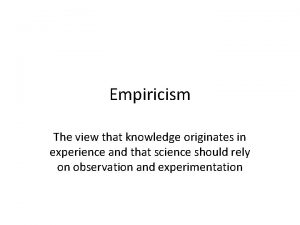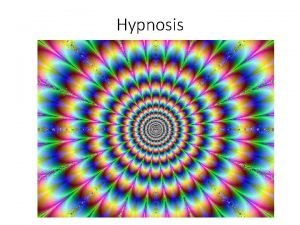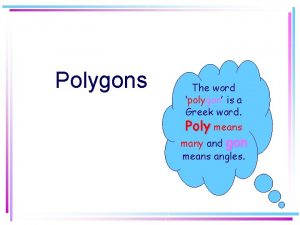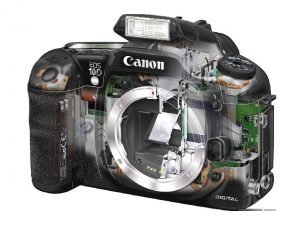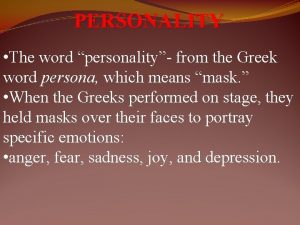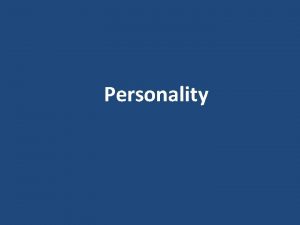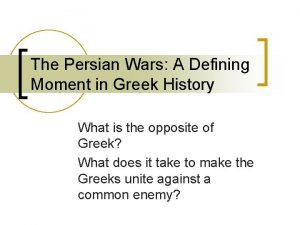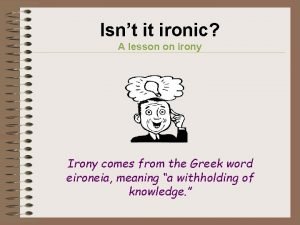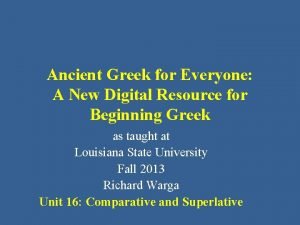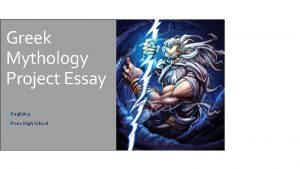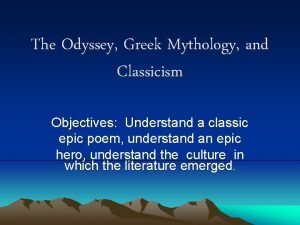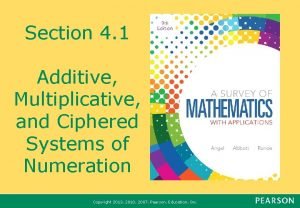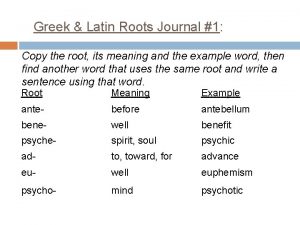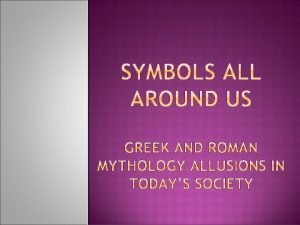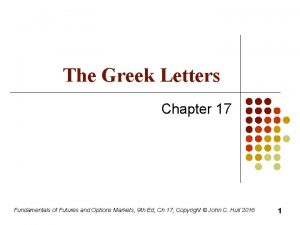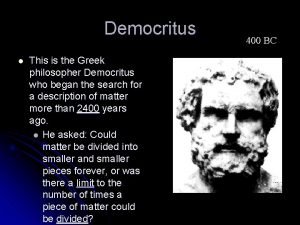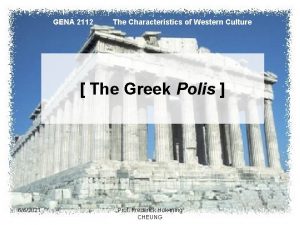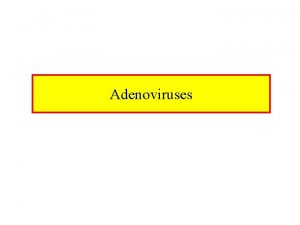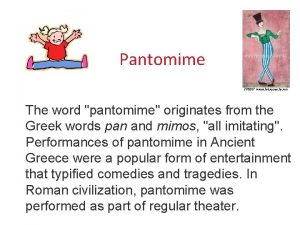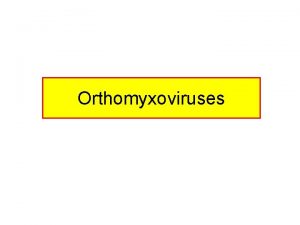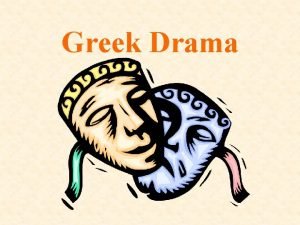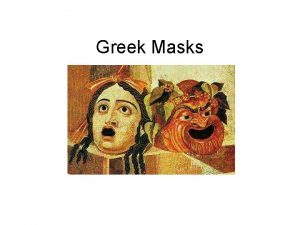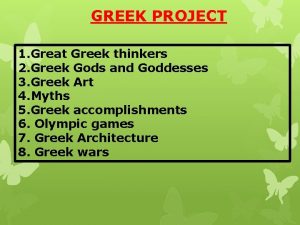Personality The term Personality originates from the Greek



































































































- Slides: 99

Personality

• The term “Personality” originates from the Greek word Persona, meaning a mask • In the ancient Greek theater, the actors carried a mask attached to a stick, it represented the character they played

Definitions: J. P. Guilford (1959) • “An individual’s personality, then, is his unique pattern of traits. ” – A trait is “any distinguishable, relatively enduring way in which one individual differs from others. ”

Definitions: Mackinnon (1959) • Personality refers to “factors” inside people that explain their behavior • The sum total of typical ways of acting, thinking, and feeling that makes a person unique.

Definitions: R. B. Cattell (1950) • The personality of an individual is that which enables us to predict what he will do in a given situation”

3 Facts to Consider When Defining “Personality” n Individuals are unique n Individuals behave differently in different situations n Although individuals are unique and behave inconsistently across situations, there is considerable commonality in human behavior

Factors Determining Personality Development • Heredity • Constitutional Factors : • The constitution of an individual is an effective factor in determining the type of his Personality. There can be 3 bodily types of personality(1) short and stout, (2) tall and thin, (3) muscular and well Proportioned. One is always impressed by an individual who has a muscular and a well proportioned body. Height, Weight, physical defects, health and strength affect Personality. • Biological Factors: • The working of the nervous system, glands and blood chemistry determines our characteristics and habitual modes of behavior. These factors form the biological basis of our personality. Adrenal gland, thyroid gland, pituitary gland endocrine gland affect personality. It is this ability which enables him to mould the social environment according to his requirements.

Heredity • Intelligence: • Intelligence is mainly hereditary. Persons who are very intelligent can make better adjustment in home, school and society than those who are less intelligent. 4. • Sex Differences: • Sex differences play a vital role in the development of personality of individual. Boys are generally more asser tive and vigorous. They prefer adventures. Girls are quieter and more injured by personal, emotional and social problems.

Environments • The sociologists emphasize that the personality of the individual develops in asocial environment. It is in the social environment, that he comes to have moral ideas, social attitudes and interests. This enables him to develop a social‘ self which is another term for personality. • Physical Environment: • It includes the influence of climatic conditions of a particular area or country on man and his living. • Social Environment: • The child has his birth in the society. He learns and lives there. Hence, the social environment has an important say in the personality development of the child.

Environments • Family Environment: • Family is the cradle of all social virtues. The first environment, the child moves in, is home. Here the child comes in contact with his parents and other family member his likes, dislikes, stereotypes about people, expectancies of security and emotional responses all are shaped in early childhood. The type of training and early childhood experiences received from the family play an important role in the development of personality.

Environments • Cultural Environment: • The cultural environment refers to certain cultural traditions, ideals, and values etc. , which are accepted in a particular society. All these factors leave a permanent impression on the child's personality. • School Environment: • Schools play an important role in molding the personality of the children because a significant part of a child's life is spent in school between the ages of 6 and 20 years. In the school, the teacher substitutes the parents. The school poses new problems to be solved, new taboos to be accepted into the superego and new models for imitation and identification, all of which contribute their share in molding personality

Other determinants of personality • • Self Concept Inter-personal Relations Psychological Factors These include one’s motives, acquired interests, attitudes, will and character, intellectual capacities such as intelligence i. e. , the abilities to perceive, to observe, to imagine, to think and to reason. Th ese factors determine one’s reactions in various situations and thus affect one’s personality, growth and direction. An individual with a considerable amount of will power will be able to make decisions more quickly than others.

Techniques of improving Personality • • • Appearance Communication Skills Self discipline Spontaneity, simplicity and naturalness Accepts and recognize weak points Attending social gathering Good listener Positive in thoughts Knowledge

• • Confidence Avoids expressing envy and bitter criticism Keeps away anger and irritation Serves and helps others Avoid judging people Appreciate and praise others Developing courage

Role of education in educa personality development






















• “Personality” as a construct may include: – Emotional responses – Social behavior – Emotional thoughts and behaviour – Motivations – Values – Interests • Methods of Measuring Personality: – Paper & pencil tests: questionnaires, inventories – Situational exercises – Field or natural observations – Projective measures

Value of Personality Questionnaires • Value to the individual (face validity) – Self-insight – Points of discussion – Norms provide comparison info

Value of Personality Questionnaires • Value to research (construct validity) – Study relationships of personality w/ other variables – Study changes over time • Value for Counseling - marital therapy - university counseling centers • Value for personnel management – Screening – Prediction of success – Placement & counseling

Disadvantage of Personality Tests • • Social Desirability Faking “Good” Faking “Bad” Random Responding

Two Main Personality Theories 1. Trait theory: people differ based on stable attributes (called “traits”) – characteristics lie on a continuum – e. g. , the Big Five 2. Type theory: people can be sorted into categories (either one type or the other) • There are many different personality inventories that measure traits or types

The Big Five • OCEAN • • • Openness to Experience Conscientiousness Extraversion Agreeableness Neuroticism

The NEO PI-R (cont. ) • Examples of Items: Neuroticism - Frightening thoughts sometimes come into my head. Extroversion - I don’t get much pleasure from chatting with people. Openness - I have a very active imagination Agreeableness - I believe that most people will take advantage of you if you let them. Conscientiousness - I pay my promptly and in full.

The NEO PI-R (cont. ) • Example Neuroticism facet: Anxiety • • I am not a worrier. I am easily frightened. I rarely feel fearful or anxious. I often feel tense and jittery. I am seldom apprehensive about the future. I often worry about things that might go wrong. I have fewer fears than most people. Frightening thoughts sometimes come into my head.

• List of Domain and Facet Scores Neuroticism Extraversion Openness Anxiety Angry Hostility Depression Self-Consciousness Impulsiveness Vulnerability Warmth Fantasy Agreeableness Trust Straightforwardness Altruism Compliance Modesty Tender-Mindedness Gregariousness Assertiveness Activity Excitement-Seeking Positive Emotions Conscientiousness Competence Order Dutifulness Achievement Striving Self-Discipline Deliberation Aesthetics Feelings Actions Ideas Values

Type Theories of Personality • Type A - Coronary-prone behavior pattern: aggressive, need to achieve more and more, workaholic, hidden lack of selfesteem (always need to prove self), always hurried, hostile • Type B – easygoing, noncompetitive, relaxed • People fall on a continuum somewhere between the two • Myers-Briggs Type Indicator

Myers-Briggs Type Indicator • Myers-Briggs: based on Jungian theory of personality – Classifies individuals along 4 theoretically independent dimensions.

MBTI (cont. ) 1. Introversion / Extroversion(E-I) : How is your general attitude toward the world? 2. Sensing / Intuition (S-N) : How do you acquire information? 3. Thinking / Feeling (T-F) : How is information processed? 4. Judging / Perceiving (J-P): How do you make decisions?

MBTI Scales Extroversion. Introversion Scale E: Oriented primarily toward the outer world; focus on people and objects I: Oriented primarily toward the inner world; focus on concepts and ideas Sensing-Intuition Scale S: Individual reports observable facts through one or more of the five senses N: Reports meanings, relationships and/or possibilities that have been worked out beyond the reach of the conscious mind

MBTI Scales Thinking-Feeling Scale Perception-Judging Scale T: Judgment is impersonally P: Preference for using a based on logical consequences F: Judgment is primarily based on personal or social values perceptive process for dealing with the outer world J: Preference for using a judgment process for dealing with the outer world

MBTI Psychometrics • Test-retest intervals range from: 1. Introversion / Extroversion(E-I) : . 73 to. 83 2. Sensing / Intuition (S-N) : . 69 to. 87 3. Thinking / Feeling (T-F) : . 56 to. 82 4. Judging / Perceiving (J-P): . 60 to. 87 u Internal Consistency intervals range from: 1. Introversion / Extroversion(E-I) : . 55 to. 65 2. Sensing / Intuition (S-N) : . 64 to. 73 3. Thinking / Feeling (T-F) : . 43 to. 75 4. Judging / Perceiving (J-P): . 58 to. 84

MBTI (cont. ) • Uses: – Career counseling – Team building – Family counseling • Criticisms: – Profiles generally positive – Barnum effect – Validation evidence is sticky – Factor analysis shows Big Five solution

MMPI • Minnesota Multiphasic Personality Inventory • MMPI-II – most widely used psychological test • 10 clinical scales and several Auxiliary

Table 4 -6 MMPI


The MMPI (cont. ) • Scale Descriptor: Psychopathic Deviate • • • Tend to act without considering consequences. Experience absence of emotional response. May feign guilt and remorse when in trouble. Are impulsive. Are not seen as overwhelmed by emotional turmoil.

The MMPI (cont. ) • Example Items: I am about as able to work as I ever was. I work under a great deal of tension. I am sure I get a raw deal from life. I find it hard to keep my mind on a task or job. I am certainly lacking in self-confidence I have difficulty in starting to do things. When in a group of people I have trouble thinking of the right things to talk about. • I cannot keep my mind on one thing. • •

Original MMPI • Items on the clinical scales of the original MMPI were selected on the basis of their ability to discriminate between normal and clinical groups. • Clinical groups were comprised of depressed, paranoid, schizophrenic, hypomanic, hypocrondriacal • Normal groups were comprised of University of Minnesota students • Initially items were selected from various sources – clinical cases, textbooks, and previous tests

MMPI II • MMPI-II was normed on a nationally representative sample – 1138 men and 1462 women • MMPI added several content and supplementary scales • A high score on a particular scale indicates the likelihood that the individual possesses those characteristics

Projective Personality Tests

The Projective Techniques • • • Projective tests allow the examinee to respond to vague stimuli with their own impressions Assumption is that the examinee will project his unconscious needs, motives, and conflicts onto the neutral stimulus Word association tests, inkblot tests, sentence completion tests, storytelling in response to pictures, etc.

The Projective Techniques (cont. ) Three features: • - - Disguised: no face validity Global: the whole personality Reveals unconscious aspects of personality Types: - Inkblot: Rorschach Picture interpretation: TAT Sentence completion: Rotter Incomplete SB Picture construction: DAP

The Rorschach Inkblot Test • The Rorschach Inkblot Test is the most commonly used projective test – In a 1971 survey of test usage, it was used in 91% of 251 clinical settings survey – It is one of the most widely used tests that exists – It is widely cited in research

History • The earliest use of inkblots as projective surfaces was J. Kerner's (1857) – He was the first to claim that some people make idiosyncratic or revealing interpretations • In 1896, Alfred Binet suggested that inkblots might be used to assess personality (not psychopathology)

History • Herman Rorschach, a Swiss psychiatrist, was the first to suggest (1911) the use of inkblot responses as a diagnostic instrument – In 1921 he published his book on the test, Psychodiagnostik (and soon thereafter died, age 38)

History • Rorschach's test was not well-received, attracting little notice – David Levy brought it to the United States - thought it was scientifically unsound. – His student, Samuel Beck, popularized its use here, writing several papers and books on it starting with Configurational Tendencies in Rorschach Responses (1933) • Several other early users also published work on he Rorschach – Several offered their own system of administration, scoring, and interpretation, leading to later problems in standardization

What is the Rorschach? • The stimuli were generated by dropping ink onto a card and folding it – They are not, however, random: the ten cards in the current test were hand-selected out of thousands that Rorschach generated • Ten blots – 5 black/white, 2 red/gray (II & III) and 3 color (VIII – X) • Thought to tap into the deep layers of personality and bring out what is not conscious to the test taker • The following are the inkblots





Administering the Rorschach • The test is usually administered with as little instruction and information as possible – The tester asks 'What might this be? and gives no clues or restrictions on what is expected as a response – Anxious subjects often do ask questions, and vague answers are offered – Some advocate sitting beside the subject to avoid giving clues by facial expression – If only one response is given, some hint to find more may be offered: "Some people see more than one thing. “

Administering the Rorschach • The cards are shown twice: – The first time responses are obtained - free association phase – The second time they are elaborated – inquiry phase

Rorschach (cont. ) Exner’s Comprehensive Scoring System 1. Location - W = whole (intellectual potential) - D = subdivisions (common sense) - Dd = details (compulsive tendencies) - DW (confabulated detail) 2. Content (i. e. , general class to where response belongs) - people, part of a person, clothing, animal, part of an animal, nature, anatomical

Rorschach (cont. ) 3. Determinants (i. e. , specific property of the blot) - F = shape/outline (rational approach) - M = movement (imagination) - C = color (emotional reactions) - Y = shades of grey (depression) 4. Form Quality 5. typical vs. unusual response 6. time

Rorschach (cont. ) § § § norms = unrepresentative inter-rater reliability test-retest reliability construct validity criterion validity

Psychometric Properties of the Rorschach • The Rorschach is a popular test, however, it has been plagued by low reliability and validity. • Obviously, it is difficult to measure any of the usual psychometric properties in the usual way – Validity and reliability are usually low because of the open-ended multiplicity of possibility that is allowed and by the lack of universally-accepted standardized instructions, administration protocol, and scoring procedure

Interpreting the Rorschach • Uses norms for five groups: nonpatient, outpatient nonpsychotic, inpatient character problem, inpatient depressive, inpatient schizophrenics one • Deviation from norms can mean an invalid protocol, or brain damage, or emotional problems, or a low mental age (or just an original person)

Psychometric Properties of the Rorschach • Reliability studies that have been done find r-values varying from 0. 1 to 0. 9 • Parker (1983) analyzed 530 statistics through meta-analysis (9 studies) and found an internal reliability of. 83 • W responses has been linked to general intelligence (r = 0. 4); Movement responses are said to suggest strong impulses or high motor activity; DW (confabulatory) responses are taken as signs of a disordered state; low response rate is associated with mental retardation, depression, and defensiveness • Overall, more research is needed to determine the reliability and validity of the Rorschach.

Thematic Apperception Test (TAT) • Construct a story about what you see on the following picture Describe: - what led up to the scene - what is happening - what the characters in the story might think or feel - how the story will end


Thematic Apperception Tests • Thematic Apperception Test (TAT): 30 grayscale pictures + one blank for elicitation of stories – each contain a dramatic event or critical situation • Most subjects see 10 -12 cards, over two sessions • Based on Murray's (1938) theory of 28 social needs (sex, affiliation, dominance, achievement, attitudes etc. ) • People would project into their story their needs • Attention is paid to the protagonist in each story and his/her environmental stressors • Many variations on this 'story-telling' test exist

TAT (cont. ) • Administration: not standardized - Not the same 20 cards Not the same order Seldom 2 sessions Instructions differ • Scoring is Minimal • Low Reliability & Validity

TAT – scoring/interpretation Scoring • Congruence with picture stimuli • Conformity with directions • Conflict Psychometric properties: • internal consistency is low; • high reliability but diminishes with time, 2 months, r =. 80; 10 months r =. 50; • Inter-rater reliability vary with studies: range. 3 to. 9

Examples of Projectives Rotter Incomplete Sentences Blank (RISB) • Complete the following sentences to express your real feelings: - I like ……. . My greatest fear ……. . This PSY 3090. D instructor is ……. .

RISB (cont. ) • Designed to screen for emotional maladjustment • Info about wishes, desires, likes, dislikes, fears, and locus of control • 40 items: easy to administer (group or ind. ) • Rigorous scoring system: high interrater r • Scoring ranges from 0 to 6 • Responses are scored as to the degree of conflict expressed, optimism shown, length of responses, omissions • Psychometrically sound but less used

Draw-a-Person Test - Originally to assess children’s intelligence - Now: a screening procedure for emotional disturbance - Cannot constitute a diagnosis - The administration: • Draw a person of the opposite sex • Draw yourself

Draw-a-Person Test • Administrator Asks: - Can you please draw a person? - Draw whatever you like in any way you like? Administrator Then Asks: - Draw a person of the opposite sex?

Draw-a-Person Test (cont. ) • Subjective vs. quantitative scoring system • Clinician looks for: – Sequence of body parts – Verbalizations during the drawing process – Size & placement of figures on the page – Amount of action depicted – Systematization in doing the task – Number of erasures – Shading – Gender of picture – Over attention to certain body parts

Draw-a-Person Test (cont. . ) • Among the plausible but empirically untrue relations that have been claimed: - Large size = Emotional expansiveness or acting out - Small size = emotional constriction; withdrawal, or timidity - Overworked lines = tension, aggression - Distorted or omitted features = Conflicts related to that feature - Large or elaborate eyes = Paranoia

Other common projective tests • CAT – Children Apperception Test – (Bellak, 1975) • Word Association Test – Rapaport et al. (1946, 1968) – 60 words: neutral and traumatic – scored: popularity, RT, content, test-retest responses • Sentence Completion – Rotter Incomplete Sentences Blank – 40 sentences – evaluated on 7 point scale by “need for therapy” to “extremely good adjustment” • House-Tree-Person Test (Buck, 1948) & Draw-A-Person (Machover, 1949): Subject is asked to draw – Scoring is on absolute size, relative size of elements, omissions "If there is a tendency to over-interpret projective test data without sufficient empirical grounds, then projective drawing tests are among the worst offenders. " Kaplan & Saccuzo, Psychological Testing, 2001, p. 467

Sources of Inaccuracy in Personality Testing • Personality assessment largely depends on selfreport • Response sets may affect personality results

Social Desirability Some test takers choose socially acceptable answers or present themselves in a favourable light • People often do not attend as much to the trait being measured as to the social acceptability of the statement • This represents unwanted variance

Social Desirability (cont. ) Example items: – Friends would call me spontaneous. – People I know can count on me to finish what I start. – I would rather work in a group than by myself. – I often get stressed-out in many situations.

Faking -- some test takers may respond in a particular way to cause a desired outcome – may “fake good” (e. g. , in employment settings) to create a favourable impression – may “fake bad” (e. g. , in clinical or forensic settings) as a cry for help or to appear mentally disturbed – may use some subtle questions that are difficult to fake because they aren’t clearly face valid

“Faking Bad” – People try to look worse than they really are • Common problem in clinical settings – Reasons: • • Cry for help Want to plea insanity in court Want to avoid draft into military Want to show psychological damage – Most people who fake bad overdo it

Random Responding Random responding may occur when test takers are unwilling or unable to respond accurately. – likely to occur when test taker lacks the skills (e. g. , reading), does not want to be evaluated, or lacks attention to the task – try to detect by embedding a scale that tends to yield clear results from vast majority such that a different result suggests the test taker wasn’t cooperating

Random Responding – Detection: • Duplicate items: “I love my mother. ” “I hate my mother. ” • Infrequency scales: “I’ve never had hair on my head. ” “I have not seen a car in 10 years. ”

Impression Management – Mitigating IM: • Use positive and negative impression scales (endorsed by 10% of the population) • Use lie scales to “flag” those who score high (e. g. , “I get angry sometime”). • Inconsistency scales (e. g. , two different responses to two similar questions) • (Use multiple assessment methods (other than self-report)
 The view that knowledge originates in experience
The view that knowledge originates in experience A sea breeze usually originates during the ____.
A sea breeze usually originates during the ____. An exogenous disease originates outside the body.
An exogenous disease originates outside the body. The greek miracle
The greek miracle Hypnosis greek
Hypnosis greek A polygon comes from two greek words poly which means
A polygon comes from two greek words poly which means A figure of speech
A figure of speech Photography from the greek word “photos” meaning
Photography from the greek word “photos” meaning Origin of word graffiti
Origin of word graffiti In my understanding
In my understanding Difference between long term and short term liabilities
Difference between long term and short term liabilities Position to term rule worksheet
Position to term rule worksheet Term to term rule
Term to term rule Long term memory vs short term memory
Long term memory vs short term memory Long term liabilities
Long term liabilities Long term goal examples
Long term goal examples Nth term examples
Nth term examples Maxterm expansion
Maxterm expansion Short medium and long term planning in education
Short medium and long term planning in education Long term and short term financial planning
Long term and short term financial planning Short term human resource planning
Short term human resource planning Nth term rule
Nth term rule Greek word of personality
Greek word of personality Greek personality test
Greek personality test Phối cảnh
Phối cảnh Các châu lục và đại dương trên thế giới
Các châu lục và đại dương trên thế giới Tư thế worm breton là gì
Tư thế worm breton là gì Thế nào là hệ số cao nhất
Thế nào là hệ số cao nhất Sơ đồ cơ thể người
Sơ đồ cơ thể người Tư thế ngồi viết
Tư thế ngồi viết Cái miệng nó xinh thế chỉ nói điều hay thôi
Cái miệng nó xinh thế chỉ nói điều hay thôi đặc điểm cơ thể của người tối cổ
đặc điểm cơ thể của người tối cổ Mật thư tọa độ 5x5
Mật thư tọa độ 5x5 Bổ thể
Bổ thể ưu thế lai là gì
ưu thế lai là gì Tư thế ngồi viết
Tư thế ngồi viết Thẻ vin
Thẻ vin Thơ thất ngôn tứ tuyệt đường luật
Thơ thất ngôn tứ tuyệt đường luật Các châu lục và đại dương trên thế giới
Các châu lục và đại dương trên thế giới Từ ngữ thể hiện lòng nhân hậu
Từ ngữ thể hiện lòng nhân hậu Diễn thế sinh thái là
Diễn thế sinh thái là Vẽ hình chiếu vuông góc của vật thể sau
Vẽ hình chiếu vuông góc của vật thể sau Thế nào là giọng cùng tên?
Thế nào là giọng cùng tên? 101012 bằng
101012 bằng Hát lên người ơi alleluia
Hát lên người ơi alleluia Tỉ lệ cơ thể trẻ em
Tỉ lệ cơ thể trẻ em Lời thề hippocrates
Lời thề hippocrates Sự nuôi và dạy con của hươu
Sự nuôi và dạy con của hươu đại từ thay thế
đại từ thay thế Quá trình desamine hóa có thể tạo ra
Quá trình desamine hóa có thể tạo ra Công của trọng lực
Công của trọng lực Thế nào là mạng điện lắp đặt kiểu nổi
Thế nào là mạng điện lắp đặt kiểu nổi Hát kết hợp bộ gõ cơ thể
Hát kết hợp bộ gõ cơ thể Dạng đột biến một nhiễm là
Dạng đột biến một nhiễm là Vẽ hình chiếu đứng bằng cạnh của vật thể
Vẽ hình chiếu đứng bằng cạnh của vật thể độ dài liên kết
độ dài liên kết Các môn thể thao bắt đầu bằng tiếng chạy
Các môn thể thao bắt đầu bằng tiếng chạy Gấu đi như thế nào
Gấu đi như thế nào Thiếu nhi thế giới liên hoan
Thiếu nhi thế giới liên hoan Sự nuôi và dạy con của hươu
Sự nuôi và dạy con của hươu điện thế nghỉ
điện thế nghỉ Nguyên nhân của sự mỏi cơ sinh 8
Nguyên nhân của sự mỏi cơ sinh 8 Một số thể thơ truyền thống
Một số thể thơ truyền thống Trời xanh đây là của chúng ta thể thơ
Trời xanh đây là của chúng ta thể thơ Frameset trong html5
Frameset trong html5 Số nguyên tố là số gì
Số nguyên tố là số gì Greek map
Greek map Pempo greek
Pempo greek The defining moment in greek history is the wars.
The defining moment in greek history is the wars. 2007 greek forest fires
2007 greek forest fires Greek word for picture
Greek word for picture Superlative degree of ancient
Superlative degree of ancient Thesis greek mythology
Thesis greek mythology Objective of greek mythology
Objective of greek mythology The zappian
The zappian Ionic greek numerals
Ionic greek numerals Couvillion meaning
Couvillion meaning Greek antichrist
Greek antichrist Dionysus drama
Dionysus drama Storgē greek god
Storgē greek god Words with the root crac
Words with the root crac Hephaestus realm and symbol
Hephaestus realm and symbol What is western theatre
What is western theatre Homologoumena books
Homologoumena books Architecture greek word
Architecture greek word Evius
Evius Ancient greek actors wore
Ancient greek actors wore Greek mythology
Greek mythology Dove soap greek mythology
Dove soap greek mythology Planktos greek
Planktos greek Greek letter vega
Greek letter vega What is greek for land between the rivers
What is greek for land between the rivers Greek philosopher democritus
Greek philosopher democritus Greek philosophers who contributed in physical education
Greek philosophers who contributed in physical education Greek hero archetype
Greek hero archetype Greek pneuma
Greek pneuma Gena 2112
Gena 2112 Greek fire definition ap world history
Greek fire definition ap world history Buff god
Buff god What does pride goeth before the fall mean
What does pride goeth before the fall mean
